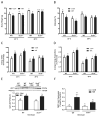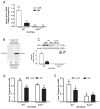The role of suppression of hepatic SCD1 expression in the metabolic effects of dietary methionine restriction
- PMID: 28982014
- PMCID: PMC5788716
- DOI: 10.1139/apnm-2017-0404
The role of suppression of hepatic SCD1 expression in the metabolic effects of dietary methionine restriction
Abstract
Dietary methionine restriction (MR) produces concurrent increases in energy intake and expenditure, but the proportionately larger increase in energy expenditure (EE) effectively limits weight gain and adipose tissue accretion over time. Increased hepatic fibroblast growth factor-21 (FGF21) is essential to MR-dependent increases in EE, but it is unknown whether the downregulation of hepatic stearoyl-coenzyme A desaturase-1 (SCD1) by MR could also be a contributing factor. Global deletion of SCD1 mimics cold exposure in mice housed at 23 °C by compromising the insular properties of the skin. The resulting cold stress increases EE, limits fat deposition, reduces hepatic lipids, and increases insulin sensitivity by activating thermoregulatory thermogenesis. To examine the efficacy of MR in the absence of SCD1 and without cold stress, the biological efficacy of MR in Scd1-/- mice housed near thermoneutrality (28 °C) was evaluated. Compared with wild-type mice on the control diet, Scd1-/- mice were leaner, had higher EE, lower hepatic and serum triglycerides, and lower serum leptin and insulin. Although dietary MR increased adipose tissue UCP1 expression, hepatic Fgf21 messenger RNA, 24 h EE, and reduced serum triglycerides in Scd1-/- mice, it failed to reduce adiposity or produce any further reduction in hepatic triglycerides, serum insulin, or serum leptin. These findings indicate that even when thermal stress is minimized, global deletion of SCD1 mimics and effectively masks many of the metabolic responses to dietary MR. However, the retention of several key effects of dietary MR in this model indicates that SCD1 is not a mediator of the biological effects of the diet.
Keywords: FGF21; acides aminés essentiels; animal models; apport alimentaire; calorimétrie indirecte; dietary intake; essential amino acids; indirect calorimetry; modèles animaux.
Conflict of interest statement
The authors report no conflicts of interest associated with this manuscript.
Figures



References
-
- Binczek E, Jenke B, Holz B, Gunter RH, Thevis M, Stoffel W. Obesity resistance of the stearoyl-CoA desaturase-deficient (scd1−/−) mouse results from disruption of the epidermal lipid barrier and adaptive thermo-regulation. Biol Chem. 2007;388:405–418. - PubMed
MeSH terms
Substances
Grants and funding
LinkOut - more resources
Full Text Sources
Other Literature Sources

